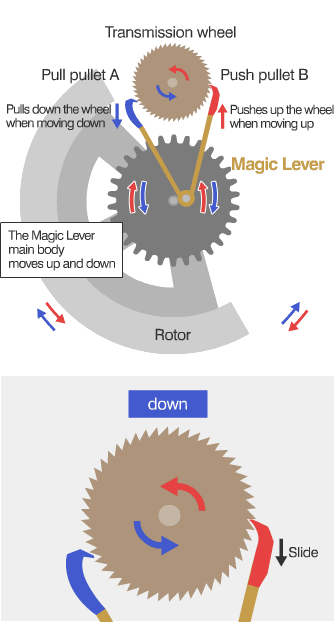
The Magic Lever, a scissors-shaped tiny part contained in self-winding wristwatches, was developed by Seiko in 1959. It has the important role of efficient winding of mainspring, by converting the rotary motion of the rotor in a self-winding wristwatch, which is generated by the arm’s movement, into vertical motion. The following describes its mechanism.
One key point of the Magic Lever is that its shaft is on an eccentric pin that is outside of the central shaft of the rotor. Therefore, the Magic Lever itself always moves up or down regardless of whether the rotor turns clockwise or anticlockwise.
Also, the Magic Lever has two spring pullets of different shapes. The tips of those two pullets pull pullet (A) and push pullet (B), are always kept in contact with the transmission wheel, which is used to rotate the barrel wheel containing the mainspring, by the spring’s force. When the Magic Lever moves down, this spring’s force makes the tip of pull pullet (A) pull and rotate the transmission wheel and push pullet (B) slides down the slope of the gear teeth.
On the other hand, when the Magic Lever moves up, the spring’s force makes the tip of push pullet (B) push and rotate the transmission wheel and pull tab (A) slides up the slope of the gear teeth.
As described above, regardless of the rotational direction of the rotor, the two pullets of the Magic Lever always generate a unidirectional movement and also make the transmission wheel always rotate in one direction, which enables efficient winding of the mainspring.
What do you think of the big role of the tiny Magic Lever? The Magic Lever is an important core part of Seiko's unique self-winding mechanism, which has dramatically increased the winding efficiency, and has been used in most self-winding mechanical watches produced by Seiko.


